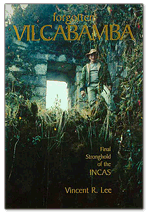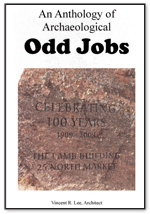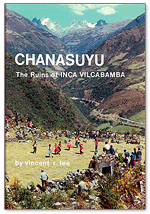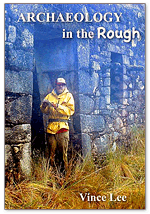Reviews of FORGOTTEN VILCABAMBA: Final Stronghold of the Incas
BOOK REVIEWS: What Others are Saying about “Forgotten Vilcabamba“
Forgotten Vilcabamba: Final Stronghold of the Incas

“Forgotten Vilcabamba, by Vincent R. Lee, is one of the great books of exploration in South America. It is a classic, partly because Lee is familiar with the (Spanish) chronicles and is a respected “Incanologist,” as well as a former Marine officer, an unusual combination. Unlike many academics, his accounts read easily and unaffectedly. He writes with casual good humor dealing with everything from stone-age jungle Indians to drunken, trigger-happy soldiers. But what lifts Forgotten Vilcabamba from many exploration accounts is Lee’s descriptions of deep, hot valleys and freezing, foggy crags and passes in a time and (yet unmapped) place where it was difficult to know just where he was. He successfully struggles to match what he found to the 16th century chronicles left by the Spaniards and the decades old writings of his predecessors, fellow Americans, Hiram Bingham and Gene Savoy.”
“Is it a guidebook or an adventure travelogue? It’s both. The first 341 pages take the reader through the highs and lows of exploration in the heartland of the rump Inca empire – the joy of discovery and comprehension, the misery of endless rain, bugs and difficult travel companions. Throughout it all, Vincent remains a man obsessed with finding and documenting Incan ruins while uncovering the details of the last years of the Incan empire. This book is the result of 18 years of hard and clearly rewarding research in both the field and the 400-year-old Spanish conquistador literature from the Vilcabamba region.”
“The success of this book is largely due to the volume and style of detailed work Vincent has completed over the years. His background (and current day job) as an architect provides him with the skills to accurately survey sites he visits and discovers. The sketches and maps produced complete the final 58 pages of the tome, whilst other sketches and believable reconstructions are sprinkled throughout the first section. They provide an excellent guide to the sites from an armchair or out in the field. Unlike most other “explorers” of the region, Vincent has managed to gain the respect of archaeologists, and after locating numerous ruins through his own research he was invited to become a member of the Institute of Andean Studies at Berkeley. Other explorers have relied almost exclusively on local guides to take them to sites reported by campesinos, the remote self-sufficient farmers of Peru. So impressed were local guiding legends the Cobos family with Vincent’s use of historical records to find previously unknown sites on his own logic, piecing together the geographical puzzles and match the land to the writings, that when they opened a hostal in Huancacalle (the closest village to Vitcos/Rosaspata) they named it “Sixpac Manco” after his expeditions and early books.”
“The travelogue section easily rivals, ‘The White Rock’ by Hugh Thomson for readability and lacks a slow midsection. The text has an appealing honesty that is extremely engaging throughout the story of how he came to explore, document and become tangled in the history of the Vilcabamba. The appendices, previously published as the pamphlet ‘Chunasaya – The ruins of Inca Vilcabamba’, provides a swath of information on all major Incan sites discovered in the Vilcabamba to date. All of the Incan roads they followed and the sites, including some pre-Inca/indigenous locations, are detailed in the text and excellent drawings by the author. We found the book to be more than sufficient during our visits to Inca Wasi, Vitcos and Yurac Rumi, which we completed without a guide – though we did stay at the Sixpac Manco Hospedaje!”
“It’s difficult to recommend this book highly enough. If it had a shortcoming, it would be in the areas it doesn’t attempt to cover. While standing at a ruin, it would be interesting to have an idea of how the areas would have been used. Knowing that a site was a fort or possibly served a ceremonial purpose is great, but what would have actually happened there on a regular basis? While Vince gives overviews of the history of the Incas, he doesn’t speculate on the daily lives of those who once lived in the ruins he found – it’s a documentation of the sites of the region and the references from the literature that match the details found in the sites to prove their identity and give insight as to their importance in history and, as such, it is pretty flawless.”
“While the book is quite expensive, it is so worth it for anyone interested in Incan ruins or visiting the region.”
Read these reviews of “Forgotten Vilcabamba: Final Stronghold of the Incas” posted at Amazon.com…
“Vincent Lee reveals the secrets and solves the mysteries of Manco Inca’s Vilcabamba in a series of splendid expeditions. His detective work and conclusions are totally convincing (and his) drawings constitute a treasure-house of new information.”
“Forgotten Vilcabamba is destined to be read and re-read for as long as people are interested in the search for and discovery of lost cities from ancient civilizations. A book that not only captures the excitement of exploration but also tantalizes one with the idea that lost cities are still out there waiting to be found. A great and thrilling read.”
“In the category of boots-on-the-ground narratives about the Incas, the true classics can be counted on one hand. Vincent Lee’s Forgotten Vilcabamba might just be my favorite. No other book captures so well the history and magic of the once-impenetrable territory that lies just beyond Machu Picchu. With his architect’s eye and superhuman curiosity, Lee succeeds in conjuring back to life the stone masterpieces erected by some of history’s greatest engineers. In the process he manages to have one hell of an adventure.”
“No ruin has ever got lost again once Vincent Lee had found it. He combines meticulously thorough exploration with a draughtsman’s eye, resulting both in superb plan maps of the Vilcabamba sites and a text that evokes the endless appeal of this rugged and rich landscape. Forgotten Vilcabamba has the great virtue too that the author always takes the Incas far more seriously than he takes himself; it is one of those rare books that combines both modesty and insight.”
“Really enjoyed ‘Forgotten Vilcabamba,’ a great story well told. We’d have been lost without it on the Vilcabamba trek.”
“A great book and wonderful read for people interested in Machu Picchu. I’m recommending that all the museum bookstores at the exhibition stock it.”
“Fabulous!. I treasure my copy. Vincent Lee should get a medal from Peru. A great read, solid and impressive.”
“I very much liked ‘Forgotten Vilcabamba,’ a well-told story of archaeological sleuthing. Unlike most expedition accounts, (Lee’s) tips its hat to other Andeanists and his local guides and porters.”
“A breath of fresh air. An illuminating archaeological adventure, told with a storyteller’s skill and without a hint of ‘archaeobabbel’.”
“Truly inspirational and a fine read.”
“A tremendous read. An interesting and entertaining ‘no-putter-downer’ with a delightful storytelling style (and a) solid scientific contribution in the appendices. I’ll be recommending (it) to my graduate students.”
“Fantastic!”
“An amazing and fascinating book.”
“Our enjoyment of the (Vilcabamba) trek was increased ten-fold. Your book made the trail come alive.”
“An enormous accomplishment. A masterpiece!”
“Congratulations and thank you (for an) easy and accessible read that made me think throughout.”
“Belongs in the library of anyone with a serious interest in the Inca. Includes dozens of aesthetically pleasing plans.”
“Vince Lee has done a tremendous service to those interested in the archaeology, history and environment of the Peruvian highlands. His book Forgotten Vilcabamba offers a comprehensive survey of the historical literature related to the Spanish conquest of the Inca and, in particular, the events surrounding the creation and destruction of Vilcabamba. His account includes the observations of various twentieth-century explorers in the region. Interwoven with the history is his own story of discovering the area and his gradual awareness of its vast untouched archaeological ruins. Lee brought his skills as an architect to the Vilcabamba documentation project, contributing more than 100 maps and site drawings, many of which are reproduced in the book. This is a wonderful story of adventure and discovery mixed with history, ethnography, and ecology. Lee’s approach and commitment should inspire other explorers to follow his lead to add to the sum of world knowledge through his scholarly approach to an exciting exploratory adventure.”




